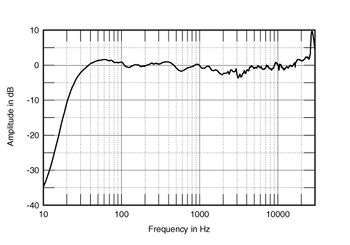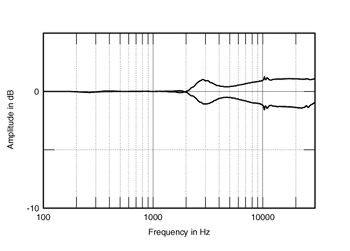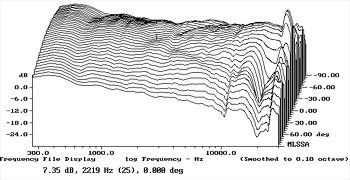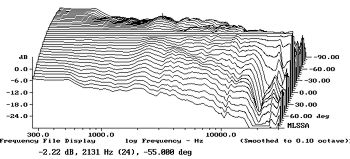| Columns Retired Columns & Blogs |
Revel Performa F30 loudspeaker Measurements part 2
But the on-axis response indicates only part of the sound that reaches a listener's ear, and so I average seven measurements at 5 degree intervals across a 30 degree window on the tweeter axis to provide a "listening window" curve. Revel does something similar, though they extend the spatial averaging to include the ±10 degrees vertical angle. My spatially averaged horizontal-window measurement is shown in fig.4, spliced to the complex sum of the individual nearfield measurements. The bass seems well-extended, with the -6dB point lying at the port tuning frequency of 24Hz. But due to the 2-pi nature of the nearfield measurement techniquethis graph does not feature the usual 3dB hump, which implies a slightly overdamped bass alignment. This would correlate with Kal's comments on the F30's bass being well-extended but a little dry. In smaller rooms, however, the upper bass will come into better balance with the midrange, meaning that Revel has made the right tradeoff, in my opinion, given that big speakers with maximally flat alignments tend to sound boomy in all but the very largest rooms.

Fig.4 Revel Performa F30, anechoic response on-axis at 50", averaged across 30 degrees horizontal window and corrected for microphone response, with the complex sum of the nearfield midrange, woofer, and port responses plotted below 300Hz.
In the upper frequencies, the trace is impressively flat, though again with a slight lack of presence-region energy apparent. From reading KR's comments on the speaker's treble balance, I suspect that his ear was latching on to the presence-region level as its reference and hearing the tweeter as being a little uptilted rather than, as can also happen, the ear taking the HF level as its reference and perceiving the presence region as being laid-back. The F30's level control provides quite accurate calibrated correction (fig.5) of the tweeter's output; still, in his room, Kal felt there to be too much top-octave energy.

Fig.5 Revel Performa F30, effect of tweeter-level control set to "±1dB," normalized to response on HF axis at 50" (5dB/vertical div.).
As KR implies, this perceived balance will also depend heavily on the speaker's dispersion. The big Performa's horizontal radiation pattern is shown in two different ways in figs. 6 and 7. Fig.6 shows the actual responses to the speaker's sides, fig.7 just the differences between those responses and the tweeter-axis response. Despite its relatively wide baffle, the F30 has a superbly well-controlled dispersion—note how evenly spaced the "contour lines" are in these graphs. While the tweeter's output in the top audio octave doesn't drop off quite as rapidly to the sides as I have seen with other 1" domes, it does get reasonably directional above 10kHz.

Fig.6 Revel Performa F30, lateral response family at 50", from back to front: responses 90 degrees-5 degrees off-axis, reference response on HF axis, responses 5 degrees-90 degrees off-axis.

Fig.7 Revel Performa F30, lateral response family at 50", normalized to response on tweeter axis, from back to front: differences in response 90 degrees-5 degrees off-axis, reference response, differences in response 5 degrees-90 degrees off-axis.
- Log in or register to post comments




































